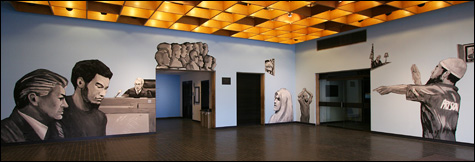
EVIDENCE? Raad/Boueri’s I Feel a Great Desire to Meet the Masses Once Again. |
“We Can Make Rain but No One Came To Ask” | Brown University’s Bell Gallery, 64 College St, Providence, Through May 25 |
Walid Raad’s installation, We Can Make Rain but No One Came To Ask, at Brown University’s Bell Gallery, feels like a Borgesian detective story in which truth is elusive, and cities themselves shiver with post-traumatic stress disorder.For several years, the Lebanese-born New York-based artist has made art about the Lebanese Civil War of 1975 to 1991. This installation, Raad writes, focuses on a single car bombing in Beirut in 1986. The gallery is filled with five long tables, with 44 sheets of paper laid atop them like evidence. A fractured, impressionistic 17-minute video projected on a wall of the gallery seems to cover some of the same territory.
“My photographs [of Beirut] began to manifest colors and lines that were, at times, significantly different from the ones available to my eyes,” Raad writes in a group of pages that depict buildings mirrored, turned upside down, cut-up, and blurred. “I came to believe that something in . . . the time and space of the [bombed] neighborhood may have been affected not only by the 1986 detonation but also by every other war, skirmish, and assault in Lebanon since 1975 . . . I decided to print my photographs even if I still doubted what I was seeing in them.”
That doubt between fact and fantasy is central to Raad’s project. Working in his own name or seeming to collect information about the Lebanese civil war under the banner of his fictitious foundation, the Atlas Group, Raad mixes facts and invented tales to toy with the nature of history, of memory, of rumor, of evidence. One message is, perhaps, that history is a slippery thing, and “truth” changes depending on who’s telling the story.
Each set of papers offers a page or so of text and then images stripped across the top of the rest of the sheets. The small type is difficult to read, making the already dry text somewhat tedious. Raad tallies bombing data, discusses the fear the attacks inspired, insists the motives and culprits can be deciphered, identifies people allegedly behind the attacks, and adds that he’s surprised that no one tried to piece it together before. Perfunctory pictures show bomb damage diagrams and photos of bodies on the ground, rescue crews, and smoke rising from buildings.
Raad writes about a newspaper photographer reporting on the blast and recounts meeting with retired Lebanese Army explosives expert Yussef Bitar in recent years to discuss bombings that he investigated. “He never told me why he copied and kept the reports in his apartment,” Raad writes. “I suspect it was the hope that some day he might present them in court to prove that his originals had been altered time and again by . . . corrupt politicians and judges.”
The walls of the gallery’s lobby are painted with black-and-white copies on blue backgrounds of what appear to be courtroom sketches of terrorism trials — judges, attorneys, a repeated figure resembling convicted al Qaeda conspirator Zacarias Moussaoui. A sign says it’s titled I Feel A Great Desire to Meet the Masses Once Again and painted by Elly Boueri at Raad’s request. She writes that for months after September 11 she struggled to remember the color of the sky that day, but prosecutors repeatedly spoke of the clear blue sky while avoiding discussion of the “geopolitical, historical, and social
reasons” for the attacks.
Boueri, though, is apparently an invention of Raad. Which makes all the apparent “evidence” that Raad has assembled begin to shake and shift and blur, just like his pictures. So Bitar, for example, was a real explosives expert, but who knows how much else is true. Such fake identities and meta-realities are a trendy tactic in contemporary art. Here it feels like a fussy distraction from and perhaps avoidance of the serious matters at hand.
But a more generous way of seeing it is that Raad is recreating the sensation of craving information and answers in the wake of a grand national catastrophe, when rival factions have framed what happened for their own benefit, making all evidence feel frustratingly slippery. So we struggle to make sense of it, latching onto what facts and memories and tales that we can.